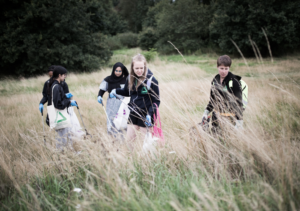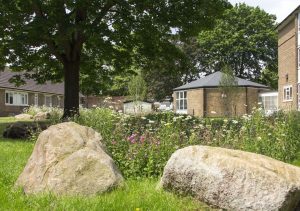BLOG: Chicago, heatwaves, climate change and Groundwork
Earlier this week the Met Office announced its first ever red weather warning for heat. Forecasts predicted that some parts of the UK would hit 40 degrees Celsius, or higher, for the first time since records began.
Not all commentators could see what all the fuss was about. There are plenty of pundits and politicians keen to tell us it isn’t a big deal and we should tough it out – generally from their air-conditioned offices.
 Opinions aside, what we do know is that heatwaves are going to become more common and more dangerous, even in the unlikely event that we hit the target of keeping the increase in global temperatures below the 1.5 degree Celsius set by the Paris agreement.
Opinions aside, what we do know is that heatwaves are going to become more common and more dangerous, even in the unlikely event that we hit the target of keeping the increase in global temperatures below the 1.5 degree Celsius set by the Paris agreement.
I got my first taste of that today, dropping my son at school in blistering heat. The class had been told to dress in whatever they liked to keep cool, the last bits of end of term learning abandoned for a cooling water fight. On the walk home, I saw the bodies of three animals, dead from heat exhaustion. Wildlife that didn’t get the memo about toughing it out. The tarmac of the roads was already starting to melt and it wasn’t even 9am. By the end of the school day the heat is forecast to hit 39 degrees Celsius here.
What does all of this mean for Groundwork?
I’m a historian by training, so my instinct is always to look for lessons in the past. In this case, to the 1995 Chicago heatwave. Not unlike pundits today, the mayor of the time there attempted to minimise the risk, telling the local press:
It’s hot. It’s very hot…. We go to extremes in Chicago. And that’s why people like Chicago. We go to extremes.
By the end of the heatwave 739 residents had died from the heat. The morgues were so full that hospitals had to hire refrigerated trailers normally used for meat to store the bodies.
So, what went wrong?
The weather obviously played a big role, but a huge part of the problem was social. Neighbourhoods that were wealthier, and had predominantly white residents, weathered the heat with few issues, protected by their leafy streets and air conditioning. Instead, most of the victims were black and died alone in more densely built and poorer neighbourhoods.
At Groundwork we all know about the importance of cutting greenhouse gas emissions before it’s too late. That’s why we’re helping communities to go green by helping them to nurture green spaces, to protect nature, to learn through environmental education projects, supporting them to mobilise young green activists and much more.
We also know that despite that, even in the best-case scenario, our communities are going to face more extreme weather events like the one today and the one in Chicago in 1995. As you would expect, our answers to this a nature-based. Our teams are upgrading the infrastructure of our neighbourhoods with measures like green roofs, nature-based sustainable urban drainage schemes and tree planting to protect them from flooding and heat.
However, one of the lessons from the 1995 heatwave in Chicago is that physical infrastructure is only part of the solution. In the aftermath of the tragedy, researchers found something odd. Neighbourhoods that were otherwise identical had a huge difference in death rates. Two neighbourhoods: North Lawndale and Washington Heights, were similar in many ways. Both had many people on a low income, both were majority black and both had similarly dense housing. But death rates in North Lawndale were much higher. Although poverty and the legacy of decades of racist policies definitely played a role, it wasn’t the whole story.
The main reason for the difference? Social infrastructure. Washington Heights was a thriving community but North Lawndale had been abandoned and underinvested in by the local government and businesses for years. In Washington Heights neighbours checked on each other, people most at risk from the heat felt safe enough to shelter in air-conditioned shops and libraries. In North Lawndale people died alone because they were afraid to leave their home, didn’t know anyone or had nowhere to go.
This is heart breaking, but the good news is that the city learned from its mistakes. A few years later, in the severe 1999 heatwave, the local government briefed the media better, opened cooling centres and crucially had systems in place to check on people at risk. This significantly reduced the number of people that died.

For Groundwork too there is an important lesson – when it comes to severe weather events, building community spirit is just as important as creating physical infrastructure.
The best part is that this means that all the fantastic community projects we’re doing already, and the benefits from them for people and nature, are also on the frontline in responding to climate change.
Every time Grow Speke in Liverpool help someone at risk of food poverty, they are also connecting with people at risk in extreme weather. Every grant to a community group builds social connections in their area to help people to watch out for each other. While Westminster Wheels in London are helping people into work, they are also helping a high street to thrive, making people feel safe enough to seek help. When a Green Doctor in Leeds visits an isolated resident, they are connecting them to a wider support network. It’s also true when you read about Groundwork USA’s work on social and environmental justice, including in Milwaukee just a couple of hours drive from Chicago.
So next time you read about our community libraries in Blackpool or inter-generational projects in Manchester – or any of the thousands of other wonderful projects that we run – it’s good to know we’re also helping to create more resilient communities that are better able to face the challenges of the future.
Ben Leach, Digital Communications Co-ordinator, Groundwork UK
If you want to learn more about the 1995 Chicago heatwave I highly recommend this podcast: https://timharford.com/2022/07/cautionary-tales-chicago-when-it-sizzles/
